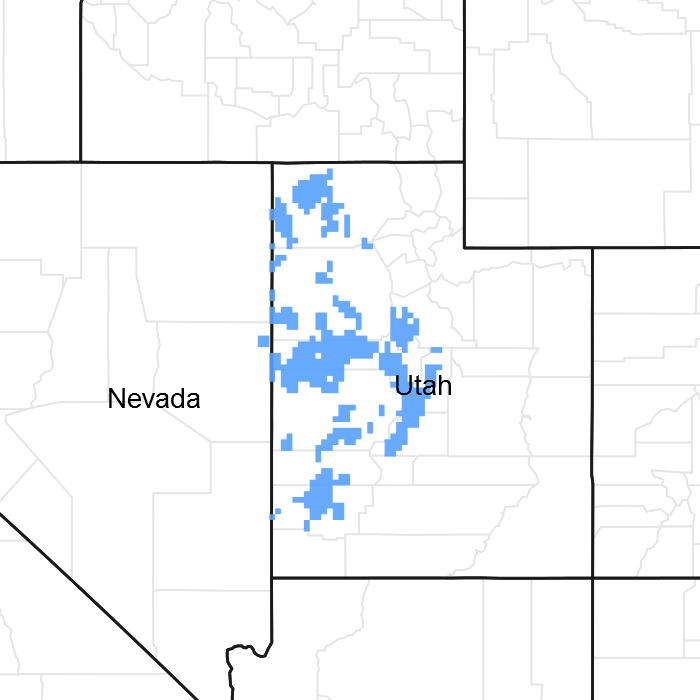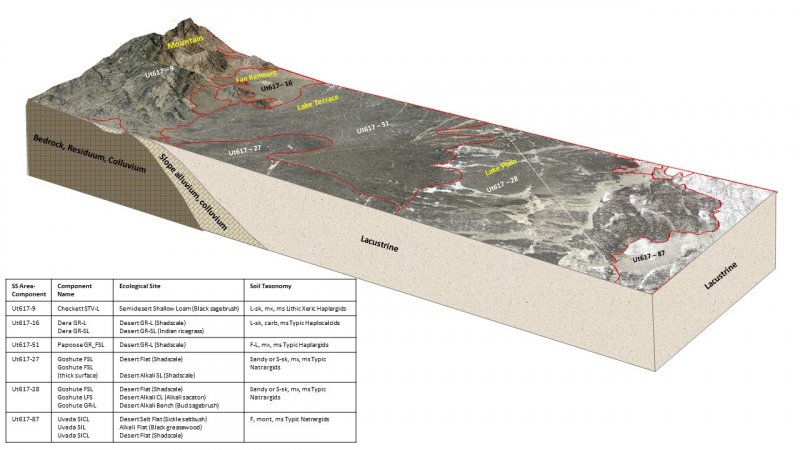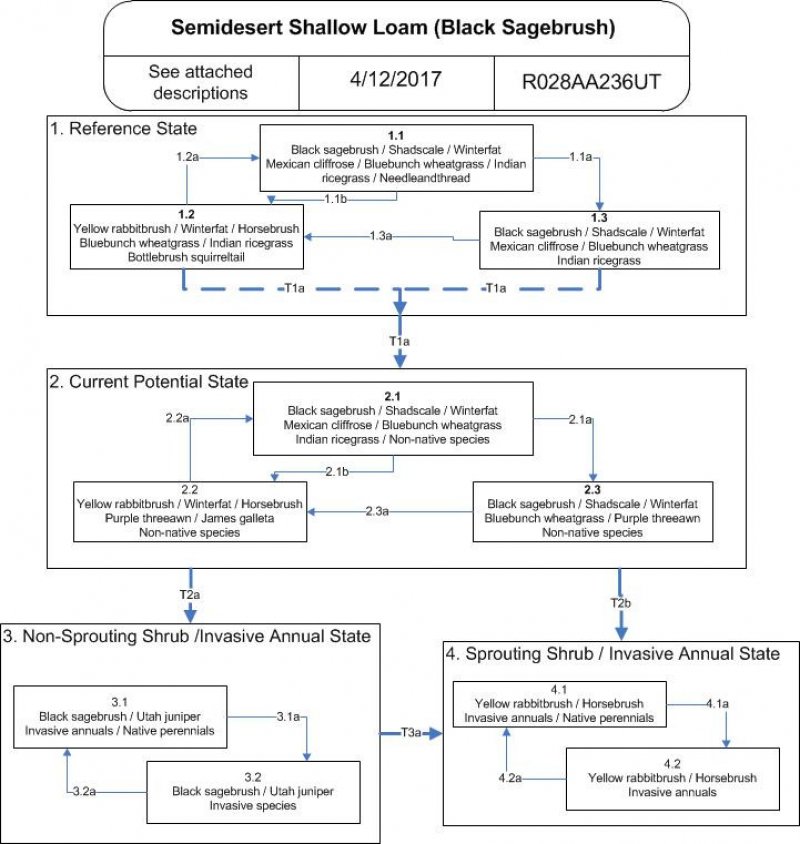Ecological dynamics
Black sagebrush is the dominant shrub in the ecological site with bluebunch wheatgrass as the dominant understory species. Fire in the Reference State can occur and increase the occurrence of fire tolerant shrubs, such as rabbitbrush (Chrysothamnus and Ericameria) and horsebrush (Tetradymia). Fire may also temporarily increase cover and production of grasses (see community phase 1.2). Shrubs can also increase in the absence of fire (see community phase 1.3). As ecological condition deteriorates due to overgrazing, lack of fire, and introduction of non-native species (see T1a), bluebunch wheatgrass and Indian ricegrass decrease, while black sagebrush, low rabbitbrush, and snakeweed increase.
Cheatgrass (Bromus tectorum) and annual forbs are most likely to invade this site. Fire return intervals are often altered and decreased after the introduction of annual grasses and forbs. This can create an altered plant community and state (see T2b and State 4). There is no known recovery to State 1 or 2 from either of these alternate states.
State 1
Reference State
The Reference State has three community phases. These community phases are influenced by disturbance, like fire. Fire can remove patches of shrubs and temporarily make grasses the dominant plant. Lack of fire can lead to an increase in shrub dominance, reducing the understory grasses.
Community 1.1
Black sagebrush/bluebunch wheatgrass
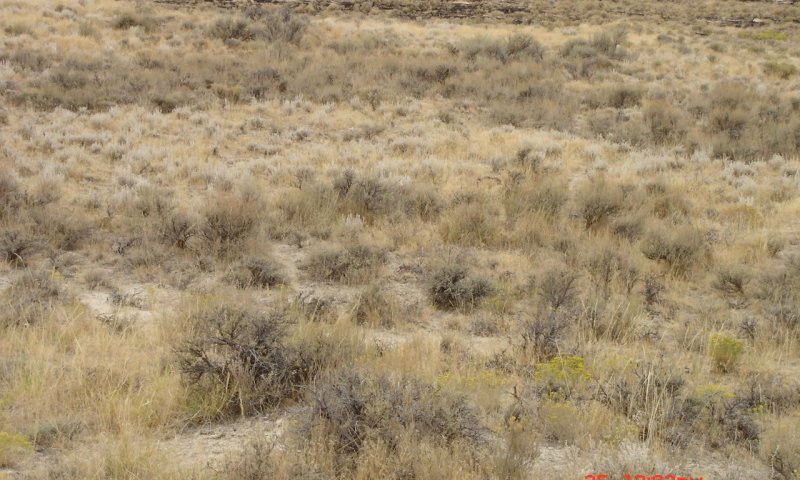
Figure 10. Photo 1: State 1, Community Phase 1.1: Black sagebrush, Wyoming big sagebrush, Winterfat, Bluebuanch wheatgrass. Location: SW of Peplin Mountain; T11N, R12W, Section 13, SW1/4. Date: 8/25/06. Photo taken by Keith Wadman
This community is dominated by Black sagebrush. Shadscale (Atriplex confertifolia) and Nevada jointfir (ephedra) (Ephedra nevadensis) are also commonly present. Winterfat (Krascheninnikovia lanata) and Mexican cliffrose (Purshia mexicana) are important browse species. Principle grasses include bluebunch wheatgrass, Indian ricegrass (Achnatherum hymenoides), needle and thread (Hesperostipa comata), and bottlebrush squirreltail (Elymus elymoides). Abundant forbs include carpet phlox (Phlox hoodia) and hairy balsamroot (Balsamorhiza hookeri). Percent composition by air-dry weight is 45 percent grass, 5 percent forbs, and 50 percent shrubs. Natural fire frequency is estimated to be 50 to 60 years.
Table 5. Annual production by plant type
| Plant type |
Low
(lb/acre) |
Representative value
(lb/acre) |
High
(lb/acre) |
| Forb |
175 |
263 |
350 |
| Grass/Grasslike |
158 |
236 |
315 |
| Shrub/Vine |
175 |
26 |
35 |
| Total |
508 |
525 |
700 |
Table 6. Ground cover
| Tree foliar cover |
0%
|
| Shrub/vine/liana foliar cover |
15-30%
|
| Grass/grasslike foliar cover |
10-30%
|
| Forb foliar cover |
2-3%
|
| Non-vascular plants |
0%
|
| Biological crusts |
0%
|
| Litter |
0%
|
| Surface fragments >0.25" and <=3" |
0%
|
| Surface fragments >3" |
0%
|
| Bedrock |
0%
|
| Water |
0%
|
| Bare ground |
0%
|
Table 7. Canopy structure (% cover)
| Height Above Ground (ft) |
Tree |
Shrub/Vine |
Grass/
Grasslike |
Forb |
| <0.5 |
– |
– |
– |
– |
| >0.5 <= 1 |
– |
– |
– |
– |
| >1 <= 2 |
– |
25-35% |
25-35% |
0-5% |
| >2 <= 4.5 |
– |
– |
– |
– |
| >4.5 <= 13 |
– |
– |
– |
– |
| >13 <= 40 |
– |
– |
– |
– |
| >40 <= 80 |
– |
– |
– |
– |
| >80 <= 120 |
– |
– |
– |
– |
| >120 |
– |
– |
– |
– |
| Jan |
Feb |
Mar |
Apr |
May |
Jun |
Jul |
Aug |
Sep |
Oct |
Nov |
Dec |
| J |
F |
M |
A |
M |
J |
J |
A |
S |
O |
N |
D |
Community 1.2
Yellow rabbitbrush/bluebunch wheatgrass
Black sagebrush decreases in the community. Shadscale, Mexican cliffrose, and other shrubs may decrease also. Winterfat typically resprouts and recovers. Bluebunch wheatgrass, Indian ricegrass, and other cool season bunchgrasses flourish. Yellow rabbitbrush and, at times, horsebrush (Tetradymia nuttallii) increase in the community. Much of the excess fine fuel accumulation is removed. Fire tolerant shrubs may persist as dominates for 30 years or longer.
Community 1.3
Black sagebrush
Black sagebrush increases significantly in percent composition. Shadscale, winterfat, Mexican cliffrose and other shrubs typically increase also. Shrubs become decadent due to age. Bluebunch wheatgrass, Indian ricegrass, and other cool-season bunchgrasses begin to lose vigor due to increased shrub competition and become dense with old vegetation. Percent composition by air-dry weight is 35 percent grass, 5 percent forbs, and 60 percent shrubs.
Pathway 1.1b
Community 1.1 to 1.2
Recent fire occurrence, 1 to 30 years. Site is properly grazed.
Pathway 1.1a
Community 1.1 to 1.3
Extended period of time without a major disturbance such as fire, insect damage or drought. Fire frequency extends well beyond the 50 to 60 year average for the site.
Pathway 1.2a
Community 1.2 to 1.1
Normal fire frequency of 50 to 60 years returns on the site.
Pathway 1.3a
Community 1.3 to 1.2
Recent fire occurrence, 1 to 30 years. Site is properly grazed.
State 2
Current Potential State
The Current Potential State is similar to the Reference State. Except plant communities in the Current Potential state can include native and acclimatized, naturalized and invasive non-native species. This state is irreversibly changed from the reference state because these non-native species will now remain a permanent part of the community.
Community 2.1
Black sagebrush/bluebunch wheatgrass/non-native species
This community is dominated by Black sagebrush. Shadescale and Nevada jointfir (ephedra) are also commonly present. Winterfat and Mexican cliffrose are important browse species. Principle grasses include bluebunch wheatgrass, Indian ricegrass, needle and thread, and bottlebrush squirreltail. Abundant forbs include carpet phlox and hairy balsamroot. This community is dominated by native species, but may include acclimatized, naturalized and invasive non-native species. Percent composition by air-dry weight is 45 percent grass, 5 percent forbs, and 50 percent shrubs. Natural fire frequency is estimated to be 50 to 60 years.
Community 2.2
Yellow rabbitbrush/purple threeawn/non-native species
Black sagebrush decreases in the community. Shadscale, Mexican cliffrose, and other shrubs may decrease also. Winterfat typically resprouts and recovers. Bluebunch wheatgrass, Indian ricegrass and other cool season bunchgrasses flourish. Yellow rabbitbrush and, at times, horsebrush increase in the community. Much of the excess fine fuel accumulation is removed. Fire tolerant shrubs may persist as dominates for 30 years or longer. This community is dominated by native species, but may include acclimatized, naturalized and invasive non-native species.
Community 2.3
Black sagebrush/purple threeawn/non-native species
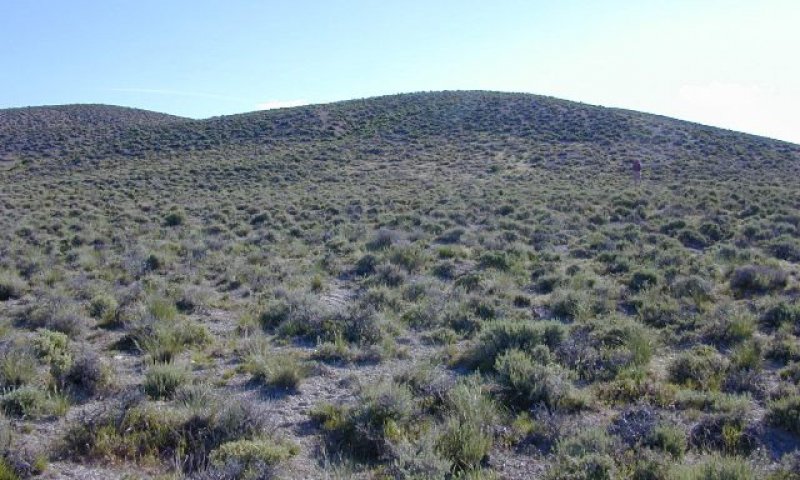
Figure 13. State 2, CP 2.3: Black sagebrush (15% cover), shadscale (3% cover), bud sagebrush (2% cover), western wheatgrass (1% cover), Indian ricegrass (3% cover), squirreltail (1% cover). Location: 313892E 4585815N. Photo by Utah GAP project 5/24/2002.
Black sagebrush increases significantly in percent composition. Shadscale, winterfat, Mexican cliffrose, and other shrubs typically increase also. Shrubs become decadent due to age. Bluebunch wheatgrass, Indian ricegrass, and other cool season bunchgrasses begin to lose vigor due to increased shrub competition and become dense with old vegetation. This community is dominated by native species, but may include acclimatized, naturalized and invasive non-native species. Percent composition by air-dry weight is 35 percent grass, 5 percent forbs, and 60 percent shrubs.
Pathway 1.1b
Community 2.1 to 2.2
Recent fire occurrence, 1 to 30 years.
Pathway 1.1a
Community 2.1 to 2.3
Long-term improper grazing (including season long, overstocking, wrong season, etc.) and/or drought remove annual and perennial fine fuels from the site lessening the potential for fire to occur. Fire frequency is greater than 100 years. Utah juniper typically invades site if a seed source is available.
Pathway 2.2a
Community 2.2 to 2.1
Fire frequency returns to within the normal range for the site (50 to 60 years).
Pathway 2.3a
Community 2.3 to 2.2
Recent fire occurrence, 1 to 30 years.
State 3
Non-sprouting shrubs/Invasive annuals State
The Non-Sprouting Shrub State occurs when the herbaceous understory is reduced. This can occur with grazing or drought. Reducing the grasses also reduces fine fuels which may reduce fire frequency. Reducing the fire frequency can lead to an increase in non-sprouting shrub densities.
Community 3.1
Black sagebrush/Utah juniper/non-native annuals/native perennials
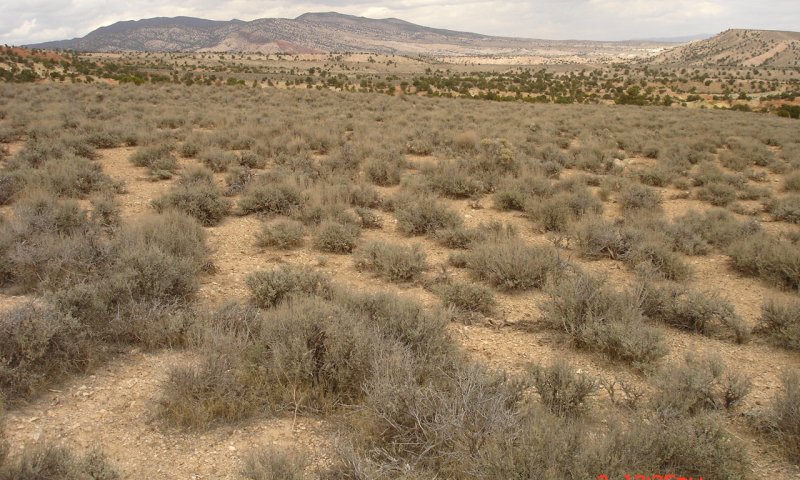
Figure 14. Photo 2: State 3, Community Phase 3.1: Black sagebrush and annual non-native species. Location: T21S, R2W, S25, NE1/4. Date 10/2/2006. Photo taken by Keith Wadman
Black sagebrush and other shrubs dominate the community. Winterfat and Mexican cliffrose are dead or dying. Remaining perennial herbaceous vegetation is declining and is mostly found only in protected locations under shrubs. Invasive, non-native grasses and weeds including cheatgrass, annual mustards, and red-stem storksbill (Erodium cicutarium) dominate the understory.
Community 3.2
Black sagebrush/Utah juniper/invasive annuals
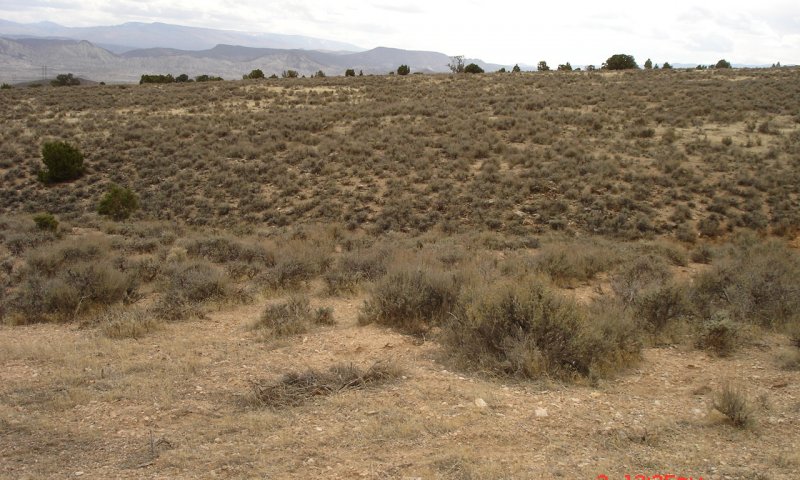
Figure 15. Photo 3: State 3, Black sagebrush and annual non-native species. Location: T21S, R2W, S25, NE1/4. Date taken: 10/2/2006. Photo taken by Keith Wadman
Where Utah juniper has invaded, black sagebrush and other shrub species decrease, otherwise they often dominate the community. Winterfat and Mexican cliffrose are mostly dead. Remaining perennial herbaceous vegetation is rare and is found only in protected locations under shrubs. Invasive, non-native grasses and weeds included cheatgrass, annual mustards, and red-stem storksbill dominate the understory.
Pathway 3.1a
Community 3.1 to 3.2
Black sagebrush/Utah juniper/non-native annuals/native perennials
Black sagebrush/Utah juniper/invasive annuals
Long-term improper grazing (including season long, overstocking, wrong season, etc.) and/or prolonged drought remove annual and perennial fine fuels from this site lessening the potential for a fire to occur. Fire frequency is greater than 100 years.
Pathway 3.2a
Community 3.2 to 3.1
Black sagebrush/Utah juniper/invasive annuals
Black sagebrush/Utah juniper/non-native annuals/native perennials
Site is properly grazed for an extended period of time. Native perennial vegetation is recovering, but annual weeds still dominate the understory. Fire frequency is greater than 100 years.
State 4
Sprouting shrubs/Invasive annuals State
This state occurs when there has been more frequent disturbance that removes sagebrush. Fire tolerant shrubs, like rabbitbrush, increase in the plant community.
Community 4.1
Yellow rabbitbrush/horsebrush/invasive annuals/native perennials
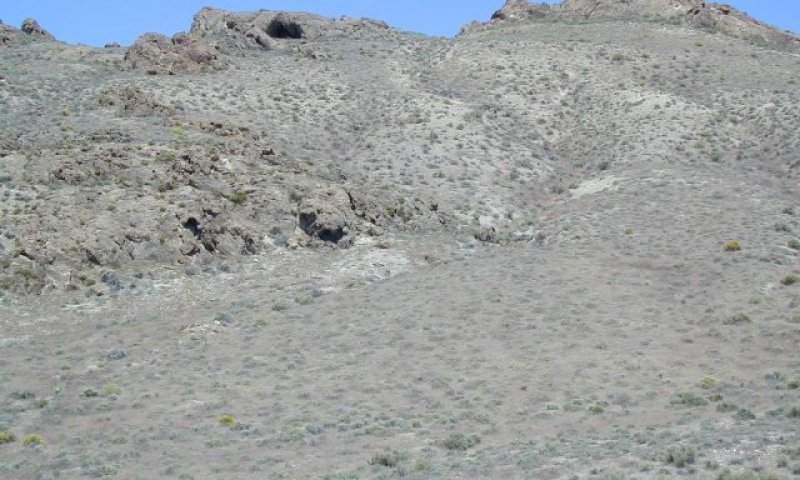
Figure 16. State 4, CP 4.1: Cover in %: 15% shrubs and 15% grasses, 5% bare ground, 60% surface rock, shadscale 7%, black sagebrush 3%, broom snakeweed 3%, ephedra 2%, cheatgrass 15%. Location 292413E 4593828N. Photo taken by Utah GAP project 7/29/2005
Yellow rabbitbrush typically dominates the shrub layer. Various horsebrush species can also be plentiful if conditions are right. Fire tolerant shrubs may persist as dominates with fire period intervals of 10 to 30 years. Broom snakeweed (Gutierrezia sarothrae), a non-sprouting species, may be an episodic dominant species in these communities when conditions are favorable. Most palatable perennial bunchgrasses are significantly reduced. Purple threeawn and James' galleta may increase. Invasive annuals including cheatgrass, annual mustards, and red-stem storksbill dominate the understory.
Community 4.2
Yellow rabbitbrush/horsebrush/invasive annuals
Yellow rabbitbrush dominates the shrub layer. Various horsebrush species can be plentiful if conditions are right. Fire tolerant shrubs may persist as dominates with fire periods of 10 to 30 years or less. Broom snakeweed may be an episodic dominate species when conditions are favorable. Only remnant palatable bunchgrases remain. Purple threeawn and sand dropseed decrease. Invasive annuals including cheatgrass, annual mustards, and red-stem storksbill dominate the understory.
Pathway 4.1a
Community 4.1 to 4.2
Long-term improper grazing (including season long, overstocking, wrong season, etc.) and/or prolonged drought reduce annual and perennial fine fuels from the site. Fire removes black sagebrush and shadscale occupying the site. Yellow rabbitbrush and, at times, various horsebrush species may become dominant.
Pathway 4.2a
Community 4.2 to 4.1
Site properly grazed for an extended period of time. Native perennial vegetation slowly recovers. Fire frequency is 5 to 30 years.
Transition T1A
State 1 to 2
Long-term improper grazing (including, season long overstocking, wrong season, etc.) and/or prolonged drought that removes fine fuels from the site lessening the potential for fire to occur. This allows both sprouting and non-sprouting shrubs such as Black sagebrush, shadscale, winterfat, and yellow rabbitbrush to increase. Shrubs may become decadent due to age. Bluebunch wheatgrass, Indian ricegrass, and other perennial buchgrasses lose vigor and decrease in the community due to shrub competition and grazing pressures. Purple threeawn (Aristida purpurea) and sand dropseed (Sporobolus cryptandrus) may increase. Utah juniper seedlings and saplings may begin to invade the community if a seed source is present.
The threshold is crossed when there is an introduction of non-native species, primarily cheatgrass and various annual mustards, that become established in the community.
Prior to crossing the threshold, if the site is properly grazed over an extended period of time, native perennial vegetation may recover. Fire frequency can return to within normal range for the site. These events could set the site back into the normal range of variability.
Transition T2A
State 2 to 3
Sustained, long-term improper grazing (including season long, overstocking, wrong season, etc.) and/or prolonged drought; reduced fine fuels resulting in the continued lengthening of a fire period and a dense shrub and/or tree overstory. This leads to a significant reduction of native perennial species and an increase in invading annuals. Utah junipers may increase to occupy a significant portion of the overstory, if a seed source is present. Black sagebrush dominates the shrub layer and may be decadent due to age. Bluebunch wheatgrass and other perennial bunchgrasses are significantly reduced due to increased shrub competition and/or heavy grazing pressure. Purple threeawn and sand dropseed may increase. The threshold is crossed when invasive annuals such as cheatgrass and annual mustards dominate the understory. The occurrence of fire extends well beyond the normal period for this site.
Transition T2B
State 2 to 4
Long-term improper grazing (including season long, overstocking, wrong season, etc.) and/or prolonged drought. Shortened fire frequency allows site to be dominated by sprouting shrubs including yellow rabbitbrush and horsebrush species. Bluebunch wheatgrass and other perennial bunchgrasses are significantly reduced due to increased shrub competition and/or heavy grazing pressure. Purple threeawn and sand dropseed may increase. Highly combustible fine fuels from invasive annuals dominate the community. Fire frequency is typically 10 to 30 years.
Transition T3A
State 3 to 4
Long-term improper grazing (including season long, overstocking, wrong season, etc.) and/or prolonged drought, shortens fire frequency which allows site to be dominated by sprouting shrubs including yellow rabbitbrush and horsebrush species. There is a significant reduction in perennial bunchgrass species. Highly combustible fine fuels from invasive annuals dominate the community. Fire frequency is typically 10 to 30 years.


